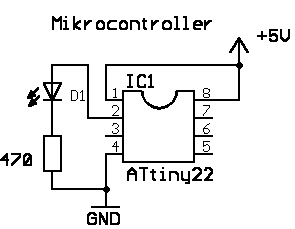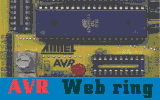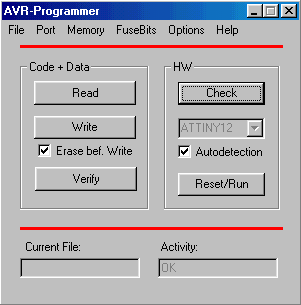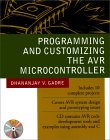|
|
Freeware for non commercial use!
| Description | |
| Downloads | |
Features:
- Programs AVR's in the Low-voltage Serial Programming Mode
- In-system Programming possible
- Write, readback and verify Flash- and EEProm-Memory
- Direct
connection between Parallel-Port and AVR (Win95/98/ME)
- Connects via Com-Port (Com1-Com8) under Win95/98/NT/ME/2000/XP
- Loads files with Intel- and Readback Format
- Many features
- High quality
AT-Prog – V3.3
|
|
|
Last changes:
|
||
|
|
|
|
||
Connection Parallelport-->Controller (Win95/98/ME):

The PC parallelport must be set to “SPP“ (standard parallelport, bios).
If you connect the PC via the Serial-Port, an Adapter is needed.
If the controller does not have an internal RC oscillator or the RC-Oscillator is deactivated, the controller must be clocked by a quartz-crystal oscillator or an external signal (see Datasheets).
Testcircuit:
A first function test can be done with the program " blink.hex
" (see ' Download '):
LED's connected at PB0/1/2/3/4 via 470 ohm resistor will flash.

DISCLAIMER:
I do not accept any responsibility for damage resulting from building or operation of AT-Prog and the interface circuits. In no event the author will be liable to you for damages.
|
programs all AVR's
in the Low-voltage Serial
Programming Mode
|
New AVR's can be defined in the file "atprog.ini" . Currently (in Mar. 2004) these controllers are included: AT90S-1200, 2313, 2323, 2333, 2343, 4433, 4414, 8515, 4434, 8535, AT-Mega8, Mega16, Mega32, Mega48, Mega64, Mega88, Mega128, Mega162, Mega163, Mega168, Mega169, Mega323, Mega103, Mega603, Mega8515, Mega8535 AT-Tiny12, , Tiny13, Tiny15, Tiny26 With a simple text editor you can add new AVR's by yourself.
|
Order
registration code |
|
|
|
to check the connection |
Books
|
Customer
Reviews: It starts you off explaining some of the basics so that even if you aren't an engineer you can understand what is being explained. The book then progresses into interfacing code with an AVR, and interfacing AVR's with other common (or not so common) peripherals. The book contains projects so that you can implement what you are learning and learn in a project-based hands-on manner. The first project is a simple program that lights an LED; the projects then progress to more complex ideas like the follow me musical toy. The projects cover both the software and hardware angles. Within hours of receiving this book I was able to get an AVR to give me visible results, I got an LED to flash! Simple I know, but it impressed me. The section on communication appealed since the idea of getting chips to "talk" to each other sounds really interesting. I didn't realise that there were so many different ways that chips could "talk" to each other. There's CAN that's used in cars, USB to talk to PC's. These different communication interfaces mean that micro controllers could be used in robots or home control amongst many other things, for example you could get a micro controller to turn down the TV volume when the phone rings. It seems really amazing that all these things are possible, and this book has shed light on these possibilities which I never knew existed. The enclosed CD contains all code that is in the book; this speeds up the process of implementing the projects, along with relevant data-sheets, application notes, and some useful software development tools. There are recommendations from where to obtain development tools, development boards etc which is useful for those who are new to the AVR. All the code in the book is well commented, which makes it easy to understand and easy to follow what is going on in the code. All in all this is a very good book. I would recommend this book to anyone
who wishes to enter the world of micro controllers or someone that already
has and needs something comprehensive and informative to refer to. |
|
|
|
|
Visit also my PIC16C84 Page.

[ Previous | List
Sites | Next | Random
Site]
[ Previous 5 Sites | Next
5 Sites | Join
]

